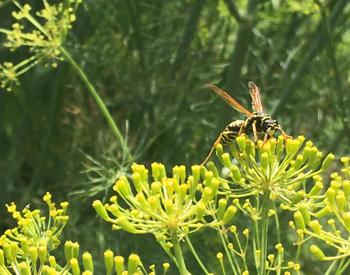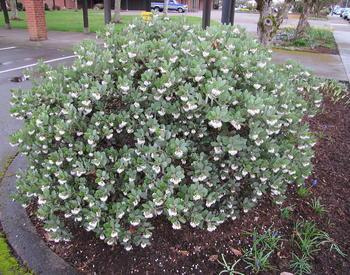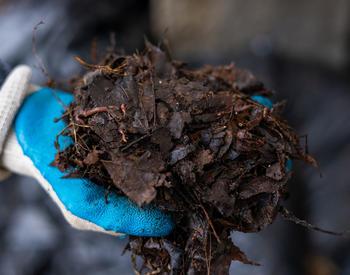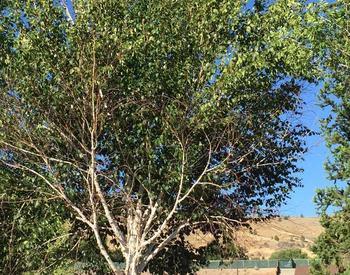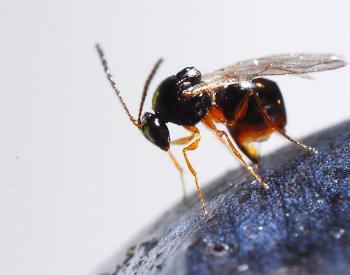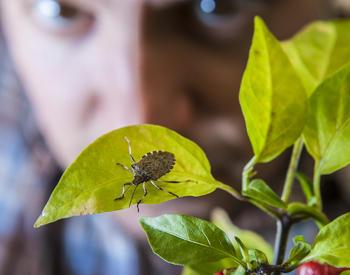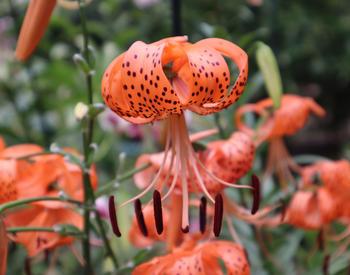Transcript
Speaker 1: From the Oregon State University Extension Service, this is Pollination, a podcast that tells the stories of researchers, land managers, and concerned citizens making bold strides to improve the health of pollinators. I'm your host, Dr. Adoni Melopoulos, assistant professor in pollinator health in the Department of Horticulture.
Speaker 2: We take a certain pride here at Pollination in bringing you stories of pollinators that you are just not going to hear about elsewhere. My ears perked up when I got the following email from one of our listeners. She writes, there's one topic in which I've noticed has not received an episode on or has really been mentioned, chloroparicitic bees.
I know that the majority of pollination is focused on how bees act as stewards for ecosystem services and less on the bee life histories, but I believe that the topic of chloroparicitism is incredibly underrepresented in the pollinator realm and can have some interesting implications regarding pollinator communities and thus pollination itself. Well, I really wanted to get this person on our show and I'm bringing you today a podcast with Casey Hale. Now Casey is a lab research technician in the Padeva Lab at Cornell University, and this is a really interesting episode telling you about the kind of some of the broad strokes of how bees that parasitize other bees live.
Not only the ones that live on solitary bees, but also social parasites, parasites, bumble bees that are parasitic on other bumble bee species. It's a fascinating episode and I'm glad to finally bring you this glimpse of something that I think you're never going to hear anywhere else. Hope you enjoyed the episode.
So, I'm very excited to have Casey Hale here from Cornell University. Welcome to Pollination. Thanks.
Thanks for having me. I'm really glad to have you and on past episodes, we've learned a little bit about the twists and turns that evolution has wrought on pollinators, but one feature we've really neglected is the real prominent role that has played a role with bees, and this is the evolution of kleptoparasitism. Can you begin by just giving us a sense of how the life of a kleptoparasitic bee is different from that of the bee that we've talked about in previous episodes?
Speaker 3: Yeah, of course. So, the first thing I want to feature is that there are a lot of different terms for kleptoparasitic bees. So, if I refer to them as different things, I just want to make that clear. So kleptoparasitic bees are synonymous with cuckoo bees and even brood parasitic bees.
So those all, those terms all mean the same thing. So kleptoparasitic bees are a lot different than the bees that we know and love. So, most bees will spend a lot of time collecting floral resources, so nectar, pollen and floral oils and they, you know, I'm just talking about solitary bees here. I'm not talking about you social bees, but solitary bees will make their own nests. They will, you know, depending on where they live in the ground or in stems, they will provision a cell and put an egg in it and they'll have many cells in one of their nests and they spend a lot of their time collecting these floral resources to put in with their larvae so that they have something to eat. Kleptoparasitic bees don't do this. They actually don't really spend a lot of their time collecting floral nectars and pollen.
What they do is they are actually kind of robbing in a way. So, they will find these solitary bee nests, the nests of bees, bees that have taken all this time to, you know, excavate a nest and collect all these resources. So, these kleptoparasite bees will find this nest and actually go into it and lay their own egg inside of a cell in these nests.
So, they don't have to collect all of these floral resources and spend the time creating the nest themselves. Sneaky. Yeah, it is. It's actually very smart.
And most commonly, the adult will go into the nest, lay, you know, its own egg, and then the invading egg when it hatches will kill the host larvae or the host egg itself that is already in the nest and then will utilize the resources inside of this nest, inside of the cell and, you know, develop that way.
Speaker 2: I imagine this is a tough lifestyle. I was just thinking, you know, I wouldn't want to go down a dark hole and take my chances and slip it, but they must have highly evolved to this lifestyle. I can totally see the benefits of it. Why, how common is this? I mean, it seems like a good deal.
Speaker 3: So, it's actually a lot more common than what you would think. So, kleptoparasites is a life history character that is in about 12 to 13 percent of all bee species that we know. So really that many. Yeah, it's quite a lot. And so, you know, we have 20,000 species of bees that are described currently. So that's what 2400 species of kleptoparasites, which is actually more common than new sociality, which is what we think of when we think of bees themselves.
Speaker 2: Wait a second. So let me get this straight. So, you know, and I know we've talked about solitary bees. We had Dr. Brian Danforth one of those new book solitary bees. We know that they're, you know, a prominent, but we, you know, most of our listeners think about social bees as being, you know, the first thing that they encounter, they encounter honeybee or bulby. You're telling me that kleptoparasitism is more common than among in terms of species than social bees. Yes. Well, be darned.
That is amazing. So, so I'm coming back to that, that, that, you know, that kleptoparasitic bee that, you know, goes down a solitary bee nest hole or I imagine this is a tricky, this is not for the faint of heart. Their evolution has probably exerted a lot of pressure on these bees. How are they different morphologically in their behavior? Tell us a little bit about that dimension. Yeah.
Speaker 3: So, I'll start with the evolution of them. We don't really know the exact mechanisms of how kleptoparasitic bees evolved. But current estimates show that they're up to 31 independent origins of kleptoparasitism would in bees.
Speaker 2: So let me get this straight. So, there's not just like one line. There's, it's evolved multiple times. Many, many times. 31. Okay. Keep going.
Speaker 3: So, because these bees have evolved so many different times, there are a lot of different characters that they have, but one kind of rule that most of them have, it's called Emory's rule. And it's that kleptoparasites will parasitize bees that are extremely closely related to themselves. So, it's really rare to have a kleptoparasite that has a host that is outside of its own bee family. So that gives us a lot of detail into maybe how these guys evolved or ladies evolved, I guess I should say, is it as a female that is laying the egg, right? But this shows that kleptoparasitism may have evolved when individuals decided to take advantage of their own conspecifics and then slowly evolved into their own species, which is why they're so closely related.
Speaker 2: And I can imagine as well, they bring along that evolutionary skill set of navigating that, you know, either cavity nesting system or ground nesting, but they somewhere in there in their behavioral, they've got some understanding how this whole thing works.
Speaker 3: They because they're so closely related, they have, you know, very similar floral resource needs. They eat the same pollen, right? Right.
Speaker 2: So, because these bees have very specific nutritional demands, their physiology is adapted. That would be switching to a completely different host might have all sorts of changes they'd have to make. Yeah, exactly. Okay.
Speaker 3: And within these radiations of bees, there are actually some families that don't have any kleptoparasite at all. So right now, like andrenidae and militidae don't have any known kleptoparasites, whereas some of the large families such as APA Day have many, many different radiations of kleptoparasitism within them. Okay.
Speaker 2: And I guess that that brings up a couple of things. I do remember we had an episode with Jim Cain, and he was talking about NOMIA not having kleptoparasites and that's why we have these huge nesting aggregations in Eastern Oregon is because otherwise those populations would collapse because there'd be an influx of the kleptoparasites into the population. Yeah.
Speaker 3: Yeah. And then I think your second part of that question was the behavior and morphology. Is that correct?
Speaker 2: It is, but I also just wanted to mention the other thing is that there seem to be these groups like Ardeidae that do have kleptoparasites, but they're from another group. Like there are these. So, isn't NOMADA going after?
Speaker 3: Yeah. So NOMADA, they're in, I believe in the family APA Day.
Speaker 2: So, they, that's the rare situation where this one group, the Ardeidae, don't kick off their own kleptoparasites. Some other group has figured it out from another lineage.
Speaker 3: Yeah. And then NOMADYNE's are actually the largest evolution, rapid evolution of this culture, the largest group, I guess you would say.
Speaker 2: Okay. We got into the weeds there a little bit, but just so, yeah, come back to that question. I did, I did wonder about how they're, how they're different, how they're, you know, if you, how they've, when you make that step evolutionarily to kleptoparasitism, are there some general trends in terms of morphology or other, other things that change?
Speaker 3: Yeah. So definitely morphologically, you know, these bees need to have different tools to utilize their different life histories. So, some of the, some of the, you know, surefire characteristics of these kleptoparasitic bees involve not having a scopa. So, a scopa is a, you know, a mass of these elongated branched hairs that bees use to collect pollen, you know, very efficiently.
And because these kleptoparasites aren't collecting a lot upon themselves, you know, they don't collect these resources for their developing larvae. They don't need to have this hair. So, they, you know, have a general loss of, you know, the scopa and this hair, which makes them look very like. And so, they're often mistaken for wasps by people that aren't aware of this life history. Some of the other morphological things, characters that they have, including having a thicker cuticle, which isn't necessarily something you can see, but it acts as an armor against, you know, maybe their hosts that, you know, maybe they're in the middle of parasitizing an nest and, you know, the host mother comes back, you know, they need to have a way to get out. Right.
So, the larvae of these kleptoparasitic bees will often have really large, sickle shaped mandibles that they use to attack and kill the larvae and the eggs of their hosts so that they can utilize the resources within the nest.
Speaker 2: Oh, right. Cause otherwise it'd be two of them eating the same pollen ball or something. So, they get rid of it, okay? All right.
Speaker 3: Yeah. Um, and they also will have like a very strong, sclerotized head in addition to that to kind of take these punches, I guess you can say.
Speaker 2: That is something I do want to see on YouTube. I want to see like a kleptoparasite and the host kind of like, uh, you know, going at it on a pollen ball. That'd be cool.
All right. So, it'd be very slow, uh, a slow pollen ball fight though. I imagine it's like punk, punk. Oh, have you ever seen it? Have you ever seen them do this?
Speaker 3: I have not. So, one of the things about these bees is that it's really hard to study them just because they are so specific and you have to, you know, dig up a nest and likely there probably isn't going to be a kleptoparasite in this nest. And if there is, it's hard to tell them, you know, their larvae look very similar other than, you know, the mandibles. Um, it's really hard to tell.
Usually, the kleptoparasitic eggs are smaller than their host eggs, just so they can be kind of sneakier, um, within the nest. But yeah, I've never actually seen it, um, with my own eyes. Um, yeah, but that's something that I would, I would love to see in the future.
Speaker 2: What do we know about adult behavior? I mean, we, we often see it here in Oregon. We'll have our, uh, on the lawns, we'll have Adrina start to pop up. Um, and we'll, you know, within a few days, we see, uh, the flies, uh, um, the robber flies show up, but then we see, um, the, the, uh, kleptoparasites kind of hovering around. Do they have a behavior or they kind of like waiting for the female? Are they patrolling all these nests? Like, tell us how they find these nests too. They must be hard to find. Yeah.
Speaker 3: So, adult behavior oftentimes you will find these kleptoparasites kind of scouring the ground, um, cl- you know, close to, um, where the nests actually are that, they're looking for, trying to find their hosts. Um, so, you know, most of them, you have to look down to see them rather than, you know, look straight at a flower. Um, they do still collect floral resources because they do still have to eat themselves. Um, so most of the time when I've seen them, I have seen them on flowers. Um, but I have also seen them, you know, scouring the ground too, which is really exciting to see when you know what they're trying to look for and what they're doing.
Speaker 2: You know, we, the other, I think for people who manage mason bees out here, we do have steelus poppin, and I remember the first time I saw, uh, that these are not just in the, in the ground. Some of them are on cavity nesters. And I remember I thought, man, these are small little males. And then somebody pointed out, no, those are not males because they look exactly like the mason bees in almost all ways, except they're smaller. Yeah.
Speaker 3: It's, yeah, it's very interesting to see. And it's, yeah, it's exciting once you know, um, you know what they are. You know, you'll remember that, and you'll see it. I remember, um, this past summer I was, um, outside just collecting and I was looking at this, uh, patch of goldenrod and they found a nomada, um, just feeding on the nectar, presumably for herself. Um, and on the same planet and, and Drina, who is their host. So, it was really interesting to see these two bees.
Um, obviously the nomada wasn't trying to Paris or, you know, try to find a nest, but it was interesting, you know, that this host and this, uh, clump of parasite was right next to each other.
Speaker 2: They're like, I'll, I'll see you later. Or maybe not. You won't see me again. I'm sneaky. Okay. It strikes me that we had an episode with August Jackson, who, uh, has a book out on bees of the Willamette Valley. I think that was his, if I remember right, he had some, uh, his favorite photograph was something like that. It was really kind of remarkable to see the host and, uh, I clumped a parasite on the same flower, just, um, hanging out. Yeah.
Speaker 3: It's really interesting.
Speaker 2: Okay. Well, let's take a quick break and we'll come back. We've got more questions we want to ask you about these, uh, fascinating bees. All right. Okay. Welcome back. Um, one question, um, Sarah, Cankade is here. Sarah, many people know been a previous guest and also really prominent with the Oregon bee project, the Oregon bee atlas. And she said, um, uh, you know, what about these social parasites? We've been talking about, uh, um, these bees that really have close associations, uh, with solitary bees. But what about, um, the, uh, are there parasite, uh, kleptoparasites on these, uh, social bees?
Speaker 3: Yeah. So, there are social, um, parasitic bees. They are not called kleptoparasites, um, because they do attack, uh, socially, um, evolved bees. So, they're called social parasites. Um, but these are bees that will get into the, you know, the hive or the, I will often kill the resident queen that is in the nest, and they will lay their own eggs in the host cells in the nest. And they essentially forced the host workers of that nest to raise, um, their own young, you know, the young parasitic bees. Um, and these bees are very similar to kleptoparasitic bees. And that, you know, they lack, um, a lot of the morphological features that most bees have, you know, pollen baskets and scope. But, um, and they don't forge for food for their own young themselves as well.
Speaker 2: Well, I remember with the, the, the bumblebee social parasites, um, that they are also the females are, you can tell them they're, they have a particular look to them. They're heavily armored. They're designed to take a couple punches.
You say. Okay, so here the idea is that there's a workforce already in place and that you sort of if you knock off You do this hand-to-hand battle with the resident queen and you win the nest that you could lay That the colony can make your own queens and your own males and that You're kind of hijacking the machinery of the And
Speaker 3: they do this using they have chemicals that will mimic The chemicals in the pheromones that the resident queen has so these endators will creep this chemical And that's how they trick the hive and the workers in the nest to You know carry out You know helping their parasitic bees young Because they have these chemical signals that their very own queen was Producing you know before she was killed
Speaker 2: fascinating these adaptations are remarkable I imagine people are gonna want to know more about these bees after they listen to this episode Can you walk us through some of the common be genera that are kleptoparasitic or social parasites? And are any of them easy to spot in the yard?
Can people? Notice you mentioned some of them look kind of wasp like because they've lost some of these features, but some likes the list may you know are harder to pull apart So tell us a little bit about some of these common
Speaker 3: genera Yeah, so I think the most common genus that You are likely to find is bees in the genus nomada. So these are the nomad bees And nomada is actually a word derived from the Greek word nomas, which means roaming or wandering So that's how you can find these bees, you know, that's how I've seen them oftentimes You know roaming around on the ground trying to find their hosts, which are Andrina which are mining bees But you can also find these nomad nomada bees on flowers too I work in strawberry agro ecosystems and we often find them as pollinators of strawberry and Polinrod, yeah, so they're they will Forage on flowers as well, but they're the most likely Cloptoparasitic bees that you'll find In your yard, especially if you have flowers, it's less likely that you're gonna see them roaming around on the ground just because it is harder to see them, but it does happen if you know what they look like and you know what you're looking for
Speaker 2: Well, I know in Oregon we do we We've seen we always have on our social media outreach When we start to see the we have a couple schools in Portland that have these great Established beds of Adrina and they're really reliable when you know where they are and I'll just tell folks a great spot to see them Is right outside the Oregon Zoo by the Hoyt Arboretum There's a whole bed there that has come alive for the last couple years that you can spot them on But you have to know what you have to be at the right time and know where to go because otherwise You'd never find these things. Mm-hmm.
Speaker 3: Yeah. Yeah, you definitely need to know what they look like beforehand I guess some of one of the other very common species or genera of genus of bees Cloptoparasitic bees that you can find are Coleaxis Which are the sharp tailed bees there in the family mechicillidae and they parasitize mechicillids So these bees if you look up a picture of them, they're actually very distinct and they have their tails are They're at the end of their abdomen Goes into a very sharp point, you know, which makes sense with their common name of sharp tailed bees but yeah, they also look very wasp like and I've seen them flying around. I've never seen them Looking or in a nest or going into a nest, but they are fairly common throughout the United States too And I think if someone is trying to find, you know, these cloptoparasitic bee genera If you don't know what they look like you're not gonna recognize them just because they do look like wasps so I think you know Look doing your research beforehand and looking up what these bees actually look like and then trying to find them is going to increase your chances of Recognizing them when you do see them outside.
Speaker 2: Okay, that's good, that's a great A great point and I think there are some nice resources around for just Recognizing some of these bee genera. I think even on our bees of Oregon, we have a little postcard that we distribute We have a Celia oxus on there and a nomada So in Oregon those cards have these of those 12 bees that we have on the cards there are you'll have pictures Sarah's just checking right now Examples of them, but they are kind of distinctive and I the point of them being some of the bees in your garden that you're most likely to not think are bees Yes Okay, so Maybe just to round things up. Do we know how these bees are doing? I imagine you know by since they depend on host species, they may be a vulnerable group or maybe some of them doing really well and some aren't like what's the what do we know about? About this group and status
Speaker 3: Yeah, so in terms of how they're doing we don't really know. There's not a lot of research going on in terms of Cultoparasitic bees in general, so we don't know how their populations are Just because it is really hard to study them. They are You know, they're not commonly found, you know on flowers They're in some more obscure places and they are underground and it's hard to dig up these nests and identify them So we don't know for sure how they're faring but just because they are directly dependent on the population stability of their hosts They are likely vulnerable if their hosts aren't doing so well and so We do have some you know data that Solitary bees aren't doing as well as we think so we can make inferences based off of you know If their hosts aren't doing well then club of parasitic bees likely aren't doing Well, you know at the same time,
Speaker 2: I guess I have two questions to that the first one is how specific host specific they are are they or some of them just to go to one species or do some of them have broad Targets
Speaker 3: yeah, so both most of the time are very specific but you know, we also don't know Most of the club of parasitic bees that we know that are described we don't have host records for them We just know that they are club of parasites because of their morphology. So, it's in that way It is also hard to tell You know how they're doing if we if we don't know their hosts and we can't make assumptions based off of you know Their populations and they're declining or
Speaker 2: not the last thing I was gonna say is I remember When our taxonomy was in town, he tells us that some of these groups are notoriously difficult. There's not very good Very few people can identify them to species is that correct or some groups worse than
Speaker 3: others Yeah, it's very true and we actually have it's funny. I went to ESA this a couple days ago and there was a Talk by Silas Spossert Who has worked on these club of parasitic bees and he told the story of we have a large group of unidentified bees in the Cornell insect collection and He you know is finding more and more Undescribed species of these culture parasitic bees and I think that just shows that you know A lot of people just don't know what they're looking at when it comes to trying to figure out which you know Club of parasitic bees are you know already described or not.
So, it's yeah, it's we definitely need more people researching them If we want to gain more knowledge on them and especially if we want to know if they're doing well or not
Speaker 2: Fantastic well, let's take another break and then we're gonna come back. We've got three questions to ask you, three questions to rule them all. Here we go. We're back so tell us do you have a book recommendation for our listeners?
Speaker 3: Yeah, so I have Two books in relation to club of parasitic bees. So one is Charles Mitchers bees of the world I'm sure many of you have you know heard of it or read parts of it and there's a really Good description of club of parasitic bees in his book So that's actually where I started Doing research and like learning more about these bees I think it's because a really good overview of what we know about these bees, which you know is not much but Yeah, it's a good resource and then my second B book is one more For those of you who want to be able to recognize these bees is these in your backyard by Joe Wilson and Olivia Carl Just because it has amazing pictures of you know, these nomadans And I think it's a really good resource To be able for those of you who want to be able to identify these couple of parasitic bees
Speaker 2: And it thanks for that that's a good plug because Olivia is coming out to Oregon in the first week of March She's gonna be at our annual bee vent, which is out in Lynn County And she's also gonna be at the annual conference for the Oregon bee Atlas So thank you for setting that up. It's a wonderful book and it does those pictures With the white backgrounds and the nice the easy writing style is great But I always appreciate when somebody can give me a section of bees of the world to look up Thank you for the tip Okay, our next question is oh wait a second we have another book we were talking at the break Is it yes bee book or non-bee book so you have a third book. What's the third book?
Speaker 3: Yes, so my third book is not specifically a bee book, but it is It is a science book for Those of us like myself who are in our early career as Scientists or even just want to learn more about being a scientist. It's called letters to a young scientist by eel Wilson I think it came out a couple years ago And it's a short book, but it has a lot of really interesting and helpful advice For those of us who you know who want to be scientists, but don't necessarily know how or are just starting and we have a lot of questions so and it's very It's a very friendly book in that regard, but and I like it.
Speaker 2: I changed my life Well, the one thing we haven't asked is what do you do at Cornell? So that's the one thing we've left out of this interview. So, tell us a little bit about yourself
Speaker 3: Yeah, so I recently graduated with a bachelor's in entomology from Cornell this past May of 2019 and I now work as a research technician in Two labs at Cornell so I work in agro ecology and looking at pollination diversity pollinator diversity in agro ecosystem And then I work in another lab quantifying pesticide risk to two bees in these systems So I don't work on couple of parasitisms specifically, but it is a route I am planning on taking in the future For graduate school.
Speaker 2: Well, it's really and that's a really interesting and really exciting that there's there is this kind of at Cornell It seems like there's a lot of projects that go across both those native bees and the sort of Honeybee world that the McCartt lab and the Danforth lab. There's it seems to be a lot of crossovers Between some of the projects. It seems like a lot of good stuff going on at Cornell these days
Speaker 3: Yeah, yeah, so I work in the Pomeo lab and the Cart lab, but I do work with Brian
Speaker 2: I don't see there's a third one. Hey, there you go. It's hard to keep track of it. It's just so much going on at Cornell
Speaker 3: Yeah, yeah, it's a great place for pollinators and bee diversity.
Speaker 2: I remember seeing you all at the pollinator conference in Davis and it was a really big group, and you all seem to have a lot of fun
Speaker 3: Yeah, yeah, I we were well represented there. Unfortunately, I didn't get to go just because it was in the middle of field season but yeah, we so if you're looking to do pollinator work Cornell is a great place to do that. We have a lot of resources Fantastic.
Speaker 2: Okay. Well, the next question I have as somebody who works in a lot of different methodologies your go-to tool must be I'm really curious what your answer is gonna be
Speaker 3: Yeah, so my Tool is actually a baby powder Baby powder baby powder. So, we're digging up solitary B. Ness. It's very hard to do Oftentimes these nests go many feet deep and they Themselves when you're trying to be up, it's really hard to find so you
Speaker 2: can hold a second case I'm gonna start you again. Your kind of you kind of garbled up. So, I'm gonna Okay, so just start with baby
Speaker 3: powder Actually my tool is baby powder So when we're digging up the solitary Venus, it's really hard, you know, these nests will go many feet deep sometimes and it's hard to Keep track of them, you know, the deeper you go the more likely they are to cave in them themselves Yeah, and so if we baby powder we can kind of Into the solitary Venus and it coats the you know, the walls of these of You know the tube and it's easier to keep track of them So let me get this straight.
Speaker 2: So, when you find this nest and you're like your kind of I want to find the Cleptoparasite down there or something you take like a little blower or something and you blow the baby powder down the hole
Speaker 3: Yeah, yep, and it'll because the walls of nests are waxy a lot of the time it'll stick to the sides and it's easier
Speaker 2: So then you'll take you know, you'll take a trowel and kind of like peel just start coming down And you'll be able to follow that white thread down How long does it take to I know everybody's yours perked up about this because I'm kind of I want to know how to do this So how long does it take to excavate a nest?
Speaker 3: It honestly depends when I first started excavating these nests They were pep and apis squash Venus and they go, you know fairly deep and it would take An hour and a half To dig up one nest just because you need to be very careful The deeper you go the wider you need to Get rid of the dirt around it so it doesn't all cave into the nest itself So it take a while Especially if you're learning, I mean you can spend an hour on a nest and then have it cave in on you And it's gone and it's hard, you know, you're not gonna find it.
Speaker 2: So okay, so you need baby powder Patients a trowel and what else do you need to do this?
Speaker 3: I think those are the three main things Your pride maybe makes sure Stable in that sense, you know, you're spending all this time Digging them up and then it caves in you just you know, don't get mad. Just find another one. Keep going. Okay.
Speaker 2: Okay. Those are thanks. That's some really good tips for people who might try to attempt this. Okay Last question we have is of all these species See we got a lot to choose from do you have a favorite?
Speaker 3: I Do so my favorite species of bee at the moment. I'm sure it will change Is Thyrus Hold on Thyrus Salonicus with the lilac cloak and dagger bee So it
Speaker 2: is that really its name the lilac cloak and dagger bee
Speaker 3: Yes, yep and I have a story I did a lot of work in Singapore two years ago And I was out and about collecting these bees and I there was this bright blue and black striped Bee that I had seen on a flower and I caught it and I had never seen anything like it before and it turned out to be this Thyrus Salonicus bee And it was my first exposure to clupta parasites. So, you know, this bee is a clupta parasite of amygila in the tropics And I just thought it was so amazing.
It's you know, you're decently blue Yeah, and I Just blew my mind. It was so beautiful, and I had such an interesting life history that that was really what started my interest with these bees
Speaker 2: Oh, that's a great bed not only is it remarkable, but it's also the start of your descent down the solitary I mean the Cleptoparasitic bee rabbit hole Fantastic, we'll have a picture of the bee and the show notes and all the other links. Thank you so much for taking time to tell us about this really interesting group of bees
Speaker 3: Yeah, thank you so much for having me.
Speaker 2: I really enjoyed this Thank you so much for listening the show is produced by Quinn Sin and Neil who's a student here at OSU in the new media communications program and the show wouldn't even be possible without the support of the Oregon legislature the Foundation for Food and Agricultural Research and Western Sarah show notes with links mentioned on each episode are available on The website which is at pollination podcast Oregon state.edu. I also love hearing from you and there's several ways to connect with me The first one is you can visit the website and leave an episode specific comment You can suggest a future guest or topic or ask a question that could be featured in a future episode But you can do the same things on Twitter Instagram or Facebook by visiting the Oregon bee project Thanks so much for listening and see you next week
When you think of a bee you probably think of an insect hard at work growing its nest and pollinating plants. But over 10% of bees are kleptoparasites; bees that don’t build their own nests, but are parasites on other bees. In this episode we learn the fundamentals of this highly-evolved and sophisticated way of living. To help us understand the twists and turns of kleptoparastism we had one of our listeners, Casey Hale, join us. Casey is Research Technician in the Podeva and McArt Labs in the Department of Entomology at Cornell University.
You can Subscribe and Listen to PolliNation on Apple Podcasts.
And be sure to leave us a Rating and Review!
Links Mentioned:
- Casey’s book recommendations:
The Solitary Bees: Biology, Evolution, Conservation (2019, Danforth, Minckley, Neff and Fawcett), The Bees in Your Backyard (2015, Wilson and Messinger-Carril), Letters to a Young Scientist (2013, EO Wilson) - Casey’s Go-to-Tool: Baby powder for digging up bee nests.
- Casey’s favorite pollinator: Lilac Cloak-and-Dagger Bee (Thyreus ceylonicus ssp. lilacinus)

